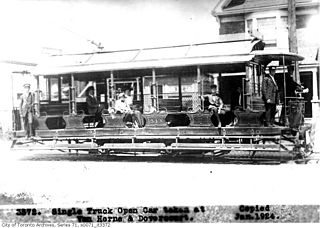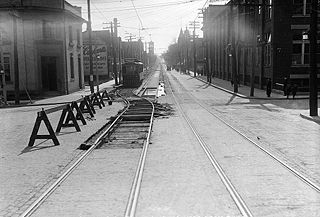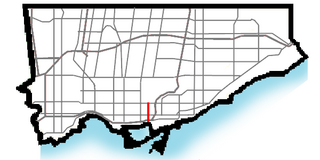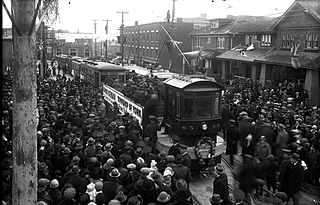

Various organizations operated streetcars on Parliament Street, in Toronto, Ontario. The Toronto Transit Commission (TTC) discontinued scheduled service on Parliament in 1966, when it opened the Bloor-Danforth subway. [1] [2]


Various organizations operated streetcars on Parliament Street, in Toronto, Ontario. The Toronto Transit Commission (TTC) discontinued scheduled service on Parliament in 1966, when it opened the Bloor-Danforth subway. [1] [2]
In 1874, the Toronto Street Railway opened the Winchester horsecar route, which ran along Carlton Street and turned north a short distance on Parliament Street to Winchester Street. In 1881, this route was extended east on Winchester Street to Sumach Street. In 1881, the TSR opened a second horsecar route on Parliament Street, the Parliament route, running from downtown on Queen Street turning north on Parliament Street then east on Gerrard Street to River Street. After the Toronto Railway Company took over the streetcar system, it electrified both the Winchester and Parliament routes in 1893. The Parliament route name disappeared in 1918 with the tracks between Queen and Gerrard Streets operating as part of the Queen route. Under the TRC, the Winchester route ran with double track on Winchester Street, east to Sackville Street, then further east on a single track to Sumach Street where there was a wye. [3] : 43, 44 [4] : 28
On September 1, 1921, the Toronto Transportation Commission (later the Toronto Transit Commission), a City of Toronto agency, took over responsibility for all streetcar lines in Toronto. At that time the Winchester route ran from Sumach Street west on Winchester Street, south on Parliament Street, west on Queen Street to loop via Church, Richmond and Victoria streets. Ex-Toronto Civic Railways Birney streetcars provided service. On July 1, 1923, the TTC renamed the route from Winchester to Parliament but did not modify the route. [4] : 28 [5] However, on September 2, a crossover was installed on Parliament Street just north of Queen Street, to become the new southern terminus of the Parliament route. [4] : 78
On August 3, 1924, the Parliament route was extended north on Parliament Street from Winchester Street to the new Viaduct Loop on Bloor Street, enabling a transfer to the Bloor streetcar line. The track on Winchester, from Parliament to Sumach, was then abandoned and replaced by bus service. [4] : 28 [5]
On January 2, 1925, one-man, ex-Toronto Railway Company streetcars replaced Birneys on Sundays and holidays, with service extended to Victoria Street. On May 5, 1940, it also became daily service. [4] : 78
On October 20, 1940, Peter Witt streetcars replaced ex-TRC streetcars on the Parliament route. [4] : 43
On December 16, 1946, special work was installed at the intersection of Parliament and King streets as part of a track extension on Parliament Street from Queen Street. The main purpose of this junction was to allow some King cars to short-turn via Parliament and Dundas streets returning via Broadview Avenue. On January 5, 1947, Parliament streetcars started to use to use the new Parliament Loop at the south-west corner of King and Parliament streets instead of looping downtown via Victoria Street. [4] : 48 [1]
On June 8, 1948, PCC streetcars replaced Witt cars in base service. [4] : 78
During the 1960s, the TTC was slowly replacing streetcar routes with bus routes. [1] When the TTC replaced most of the Bloor streetcar line with the Bloor-Danforth subway, it also replaced several north–south streetcar routes such as the Parliament route with buses.
Streetcar tracks remain in use from Carlton Street to King. The 506 Carlton streetcar route uses the block of Parliament between Carlton and Gerrard. Streetcars use the remaining track when they are shifted from one route to another or when a traffic accident or routine maintenance requires a temporary diversion.

The Toronto Street Railway (TSR) was the operator of a horse-drawn streetcar system from 1861 to 1891 in Toronto, Ontario, Canada. Its successor, the Toronto Railway Company, inherited the horsecar system and electrified it between 1892 and 1894.

The Toronto Railway Company (TRC) was the operator of the streetcar system in Toronto between 1891 and 1921. It electrified the horsecar system it inherited from the Toronto Street Railway, the previous operator of streetcar service in Toronto. The TRC was also a manufacturer of streetcars and rail work vehicles, a few of which were built for other streetcar and radial operators.

Toronto Civic Railways (TCR) was a streetcar operator created and owned by the City of Toronto, Ontario, Canada, to serve newly annexed areas of the city that the private operator Toronto Railway Company refused to serve. When the Toronto Railway Company's franchise expired in 1921, its services were combined with those of the Toronto Civic Railways, and are now assumed by the new Toronto Transportation Commission (TTC). The first route of the TCR started operation on December 18, 1912.

The Toronto streetcar system is a network of nine streetcar routes in Toronto, Ontario, Canada, operated by the Toronto Transit Commission (TTC). It is the third busiest light-rail system in North America. The network is concentrated primarily in Downtown Toronto and in proximity to the city's waterfront. Much of the streetcar route network dates from the 19th century. Most of Toronto's streetcar routes operate on street trackage shared with vehicular traffic, and streetcars stop on demand at frequent stops like buses. Since 2019, the network has used low-floor streetcars, making it fully accessible.

The history of public transportation in Toronto in Canada dates back to the middle 19th century under many different private companies, organizations and owners, which were all later unified as a single government-run entity during the 1920s.

501 Queen is an east–west Toronto streetcar route in Ontario, Canada, operated by the Toronto Transit Commission (TTC). It stretches from Long Branch Loop in the west to Neville Park Loop in the east, running on Lake Shore Boulevard, in a reserved right-of-way within the median of the Queensway, and on Queen Street. This route operates as part of the TTC's Blue Night Network service, operating from approximately 1 am to 5 am as the 301 Queen.

The 511 Bathurst is a Toronto streetcar route operated by the Toronto Transit Commission in Ontario, Canada.

504 King is an east–west Toronto streetcar route in Ontario, Canada. It serves King Street in Downtown Toronto as well as Broadview Avenue on the east end and Roncesvalles Avenue on the west end of the line. The route consists of two overlapping branches: 504A between Line 2 Bloor–Danforth's Dundas West station and Distillery Loop, and 504B between Broadview station – also on Line 2 – and Dufferin Gate Loop. The two branches overlap on King Street between Dufferin and Sumach streets, both passing St. Andrew station and King station on subway Line 1 Yonge–University.

In 1920, the Toronto Civic Railways (TCR) acquired 25 single-truck, double-ended Birney streetcars from the J. G. Brill Company. In 1921, the Toronto Transportation Commission (TTC) acquired all assets of the TCR including the 25 Birney cars. In 1927, the TTC sold 3 of the Birney cars to Cornwall, Ontario and 8 to Halifax, Nova Scotia. In 1941, the remaining 14 Birney cars were sold, again going to Halifax.

506 Carlton is a Toronto streetcar route run by the Toronto Transit Commission in Ontario, Canada. It runs from Main Street station on subway Line 2 Bloor–Danforth along Gerrard, Carlton and College Streets to High Park. Despite the route's name, less than 10 percent of its length actually uses Carlton Street.
The Relief Line was a proposed rapid transit line for the Toronto subway system, intended to provide capacity relief to the Yonge segment of Line 1 and Bloor–Yonge station and extend subway service coverage in the city's east end. Several plans for an east–west downtown subway line date back to the early 20th century, most of which ran along Queen Street.

Toronto and Scarboro' Electric Railway, Light and Power Company was established in August 1892 to provide street railway service to the Upper Beaches district within the City of Toronto, Ontario and to the neighbouring Township of Scarborough. Except for two branches, the line ran as a radial along Kingston Road.

Parliament Street is a north–south street in the eastern part of downtown Toronto, Ontario, Canada. The street runs from Bloor Street to Queens Quay and is the first major street west of the Don River.

Dufferin Gate Loop, also known as Dufferin Loop, is a Toronto Transit Commission (TTC) bus station and turning loop for streetcars near the southern end of Dufferin Street in Toronto, Ontario, Canada. During the Canadian National Exhibition (CNE), the loop becomes a primary access point for visitors entering Exhibition Place via the Dufferin Gates. This west entrance to the CNE can be reached by the Dufferin Street bridges across the Lakeshore West railway corridor and Gardiner Expressway.

The Toronto Railway Company Belt Line was a streetcar route that operated in Toronto, Ontario, Canada. The route was created by the Toronto Railway Company in 1891 and taken over by the Toronto Transportation Commission in 1921, which cancelled the route in 1923 as part of its reorganization of streetcar routes.

The Toronto Transit Commission operated the Bloor streetcar line along Bloor Street and Danforth Avenue, extending at its longest from Jane Street in the west end of the city to Luttrell Avenue in the east. Both Luttrell and Jane loops at the termini were transfer points between streetcars and suburban bus routes. The line was abandoned in 1966 with the opening of the Bloor-Danforth subway line, except for two stubs of the line abandoned in 1968.

Beginning operation in 1861, the Yonge streetcar line was the first streetcar line in Toronto and the first in Canada. It started off as a horsecar line and closed in 1954 operating two-unit trains of Peter Witt motors pulling a trailer. Under the Toronto Transportation Commission, the Yonge line was the busiest and most congested streetcar line in the city leading to its replacement in 1954 by the Yonge Subway line, also Toronto's first and the first in Canada.

The Rogers Road streetcar line was a streetcar line that operated mainly within the Township of York from 1924 to 1974. The line was owned by the Township of York Railways, which in turn was owned by its namesake municipality. The Township of York Railways contracted with the Toronto Transportation Commission, later the Toronto Transit Commission (TTC), to operate the line.

The Harbord streetcar line was an east-west line within the Toronto streetcar system. The route was named after Harbord Street even though only a small portion of the route was along the namesake street. One distinct characteristic of the route was its zip-zag nature, making many 90-degree turns onto the various streets along its route. The route was retired in 1966 when the Toronto Transit Commission (TTC) opened the Bloor–Danforth subway line, the city's first east-west subway line.

Toronto-gauge railways are tram and rapid transit lines built to Toronto gauge, a broad gauge of 4 ft 10+7⁄8 in. This is 2+3⁄8 in (60 mm) wider than standard gauge of 4 ft 8+1⁄2 in which is by far the most common track gauge in Canada. The gauge is unique to the Greater Toronto Area and is currently used on the Toronto streetcar system and the Toronto subway, both operated by the Toronto Transit Commission. As well, the Halton County Radial Railway, a transport museum, uses the Toronto gauge so its rail line can accommodate its collection of Toronto streetcars and subway trains. Several now-defunct interurban rail systems also once used this gauge.